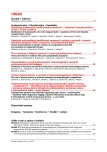Prevalence of red blood cell and HLA antibodies in multi-transfused haematological patients
Authors:
H. T. Bolcková; E. Matějková; M. Písačka; Z. Gašová; M. Böhmová; Z. Bhuiyanová; J. Žlabová; J. Čermák; A. Vítek
Authors‘ workplace:
Ústav hematologie a krevní transfuze, Praha
Published in:
Transfuze Hematol. dnes,18, 2012, No. 1, p. 25-30.
Category:
Comprehensive Reports, Original Papers, Case Reports
Overview
Blood transfusions represent an integral part of the treatment of haematological patients. One of the side effects of this therapy is the possible alloimmunisation of recipients to donor blood cell antigens, which may complicate subsequent transfusion therapy. A retrospective analysis of 100 multiply transfused haematological patients was performed. The aim of this study was to establish the prevalence of anti-red-blood cell and anti-HLA antibodies in these patients. Column agglutination methods in NAT and the enzyme test were used for screening and identification of red blood cell antibodies. The standard complement-dependent lymphocytotoxicity test (CDC-NIH) and ELISA techniques were used for screening of HLA antibodies: QuikScreen [GTI] for HLA class I antibodies detection (IgG and IgM), B-Screen [GTI] for HLA class II antibodies detection (IgG). Kit Quik-ID Class I GTI for HLA class I (IgG) antibodies. The prevalence of HLA and/or red-blood-cell alloimmunisation in our studied group was 29%. 11% of patients developed antibodies against red-blood-cell antigens, 23% of patients developed anti-HLA antibodies. The degree of immunisation differed according to gender: the prevalence of antibodies against red-blood-cell was 6.5% in women and 14.8% in men (this difference was not statistically significant). The prevalence of anti-HLA antibodies was significantly higher in women compared to men (32.6% versus 14.8%; p=0.035).
Key words:
alloimmunisation to red blood cell antigens, alloimmunisation to HLA antigens, platelet refractoriness, post transfusion reactions
Sources
1. Rebulla P. A mini-review on platelet refractoriness. Haematologica 2005; 90 (2): 247–253.
2. Imoto S, Kawamura K, Tokumine Y. Acute non-hemolytic transfusion reactions and HLA class I antibody: advantages of solid phase assay compared with conventional complement-dependent assay. Transfusion Medicine 2010; 20: 95–103.
3. Benson K, Agosti SJ, Latoni-Benedetti GE, Leparc GF. Acute and delayed hemolytic transfusion reactions secondary to HLA alloimunization. Transfusion 2003; 43(6): 753–7.
4. Ozier Y, Muller JY, Mertes PM, et al. Transfusion-related acute lung injury: reports to the French Hemovigilance Network 2007 through 2008. Transfusion 2011; 51(10): 2102–2110.
5. Guide to the preparation, use and quality assurance of Blood components 15th edition, CE, Strasbourg, Index, 189–242.
6. Terasaki PI, McClelland JD. Microdroplet assay of human serum cytotoxins. Nature 1964; 204: 998.
7. Bishop JF, Matthews JP, Yuen K, McGrath K, Wolf MM, Szer J. The definition of refractoriness to platelet transfusions. Transfusion Medicine 1992; 2: 35–41.
8. Fluit CR, Kunst VA, Drenthe-Schonk AM. Incidence of red cell antibodies after multiple blood transfusion. Transfusion 1990; 30(6): 532–535.
9. Zalpuri S, Zwaginga JJ, Cessie S, Elshuis J, Schonewille H, Bom JG: Red-blood-cell alloimmunization and number of red-blood-cell transfusions. Vox Sang 2011 Jul 6. doi: 10.1111/j.1423-0410.2011.01517.
10. Sanz C, Ghita G, Franquet C, Martinez I, Pereira A. Red-blood cell alloimunization and female sex predict the presence of HLA antibodies in patients undergoing liver transplant. Vox Sang 2010; 99(3): 261–6.
11. Van de Watering L, Hermans J, Witvliet M, Versteegh M, Brand A. HLA a RBC immunization after filtered and buffy-coat-depleted blood transfusion in cardiac surgery: a randomized controlled trial. Transfusion 2003; 43(6): 765–71.
12. Kitazawa J, Nollet K, Morioka H, Tanaka K, Inomata M, Kubuki Y, Ohto H. Non-D Rh antibodies appearing after apheresis platelet transfusion: stimulation by red cells or microparticles? Vox Sang 2011; 100(4): 395–400.
13. Godfrey G J, Lockwood W, Kong M, Bertolone S, Raj A. Antibody development in pediatric sickle cell patients undergoing erythrocytapheresis. Pediatr Blood Cancer 2010; 55(6): 1134–7.
14. McPherson ME, Anderson AR, Castillejo MI. HLA alloimmunization is associated with RBC antibodies in multiply transfused patients with sickle cell disease. Pediatr Blood Cancer 2010; 54 (4): 552–558.
15. McKenna D H Jr, Eastlund T, Segall M, Noreen HJ, Park S. HLA alloimmunization in patients requiring ventricular assist device support. J Heart Lung Transplant 2002; 21(11): 1218–24.
16. Ohto H, Nomizu T, Kuroda F, Hoshi T, Rokkaku Y. HLA alloimmunization of surgical patients by transfusion with bedside leukoreduced blood components. Fukushima J Med Sci 2003; 49 (1): 45–54.
17. Laundy GJ, Bradley BA, Rees BM, Younie M, Hows JM. Incidence and specificity of HLA antibodies in multitransfused patients with acquired aplastic anemia. Transfusion 2004; 44: 814–825.
18. Barocci S, Valente U, Gusmano R, et al. Autoreactive lymphocytotoxic IgM antibodies in highly sensitized dialysis patients waiting for a kidney transplant: identification and clinical relevance. Clin Nephrol 1991; 36(1): 12–20.
19. Cross-Sectional Guidelines for Therapy with Blood Components and Plasma Derivatives. Platelet concentrates. Transf Med Hemother 2009; 36: 379.
Labels
Haematology Internal medicine Clinical oncologyArticle was published in
Transfusion and Haematology Today

2012 Issue 1
Most read in this issue
- Asymptomatic pituitary macroadenoma oppressing optic chiasm – ‘incidentaloma‘ – identified within diagnostical staging of patient with primary extranodal diffuse large B-cell lymphoma of orbit and paranasal sinuses – a case report
- The role of physical activity in patients suffering from haematological malignancies
- Prevalence of red blood cell and HLA antibodies in multi-transfused haematological patients
- Mobilization of hematopoetic stem cells using plerixafor - experience of the Czech Republic transplantation centers
